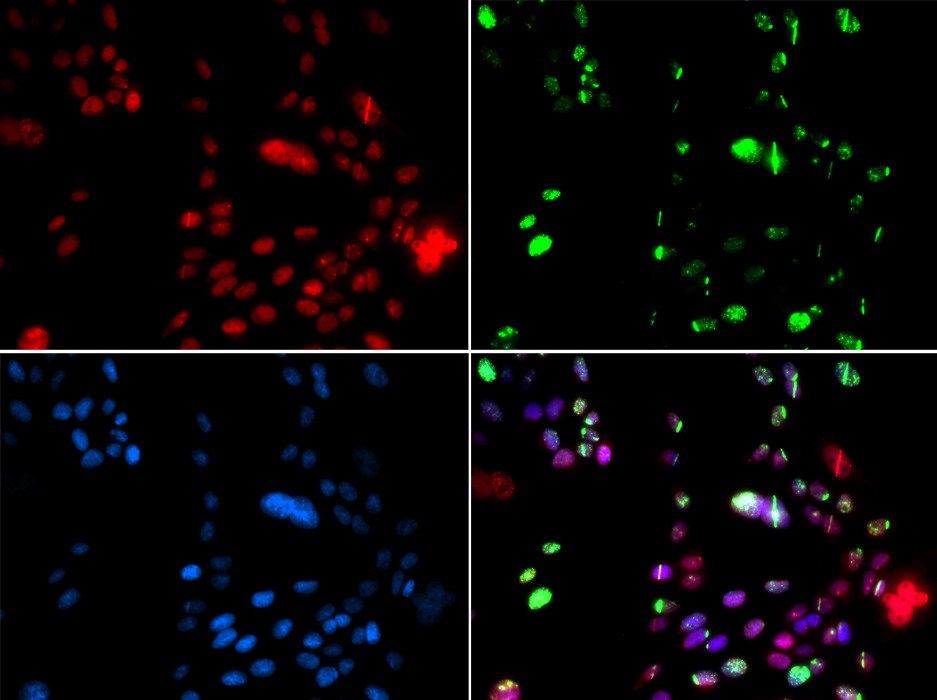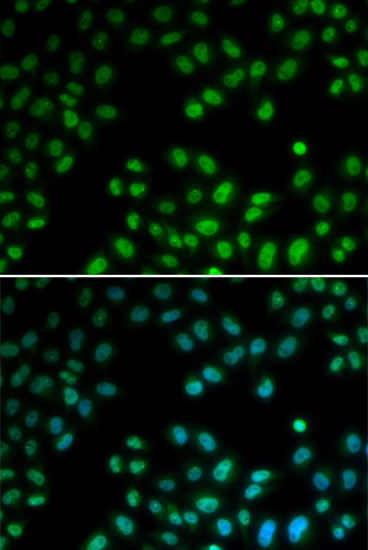-
Product Name
PIAS1 Polyclonal Antibody
- Documents
-
Description
Polyclonal antibody to PIAS1
-
Tested applications
WB, IF
-
Species reactivity
Human, Mouse
-
Alternative names
PIAS1 antibody; DDXBP1 antibody; GBP antibody; GU/RH-II antibody; ZMIZ3 antibody; E3 SUMO-protein ligase PIAS1 antibody
-
Isotype
Rabbit IgG
-
Preparation
Antigen: Recombinant fusion protein containing a sequence corresponding to amino acids 422-651 of human PIAS1 (NP_057250.1).
-
Clonality
Polyclonal
-
Formulation
PBS with 0.02% sodium azide, 50% glycerol, pH7.3.
-
Storage instructions
Store at -20℃. Avoid freeze / thaw cycles.
-
Applications
WB 1:500 - 1:2000
IF 1:50 - 1:200 -
Validations

Immunofluorescence - PIAS1 Polyclonal Antibody
Immunofluorescence analysis of GFP-RNF168 transgenic U2OS cells using PIAS1 antibody . Green: GFP-RNF168 fusion protein expression for DNA damage marker. Blue: DAPI for nuclear staining. RNF168 can be used to mark cells damaged by UV-A laser for they always gather around DNA damage region.

Immunofluorescence - PIAS1 Polyclonal Antibody
Immunofluorescence analysis of U2OS cells using PIAS1 antibody . Blue: DAPI for nuclear staining.
-
Background
Functions as an E3-type small ubiquitin-like modifier (SUMO) ligase, stabilizing the interaction between UBE2I and the substrate, and as a SUMO-tethering factor. Plays a crucial role as a transcriptional coregulation in various cellular pathways, including the STAT pathway, the p53 pathway and the steroid hormone signaling pathway. In vitro, binds A/T-rich DNA. The effects of this transcriptional coregulation, transactivation or silencing, may vary depending upon the biological context. Sumoylates PML (at'Lys-65' and 'Lys-160') and PML-RAR and promotes their ubiquitin-mediated degradation. PIAS1-mediated sumoylation of PML promotes its interaction with CSNK2A1/CK2 which in turn promotes PML phosphorylation and degradation (By similarity). Enhances the sumoylation of MTA1 and may participate in its paralog-selective sumoylation. Plays a dynamic role in adipogenesis by promoting the SUMOylation and degradation of CEBPB (By similarity).
Related Products / Services
Please note: All products are "FOR RESEARCH USE ONLY AND ARE NOT INTENDED FOR DIAGNOSTIC OR THERAPEUTIC USE"
